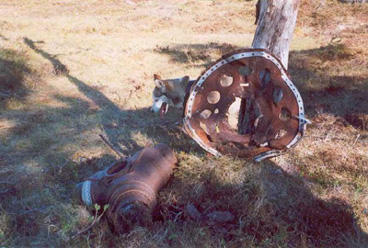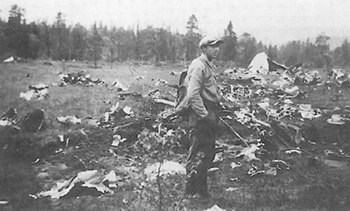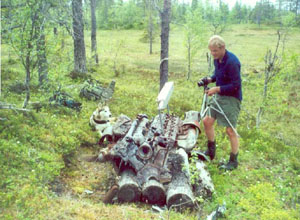W1041 ZA-B from 10 Squadron
| On 30th March 1942, the crew of Halifax W1041 ZA-B from 10 Squadron took off at 1841 hrs from RAF Lossiemouth on the North East Coast of Scotland to participate in an attack on the German Battleship Tirpitz which was moored at the time in Fættenfjord in Norway.
The weather as they flew across the North Sea was very cloudy until they reached the Norwegian coast. They were able to identify the islands of Smöla, Hitra and Fröya as they flew over them en route for Trondheimfjord, however, they then encountered low 10/10ths cloud which obscured their view of the fjords and valleys. They were unable to see the ground below and unable to locate the target jettisoned their mines at 2258 hrs at a postition 62.45 N 0600 E. The aircraft and crew returned to base and landed safely at 0205 on March 31st. |
|
Rank
|
Name
|
Force | Crew Position | Age |
Home Town
|
Fate |
| W/C | TUCK | Pilot | Returned | |||
| Sgt | PICKETT | 2nd Pilot | Returned | |||
| F/L | BUCHAN | Navigator | Returned | |||
| Sgt | STUBLEY | W/Op Air Gunner | Returned | |||
| Sgt | MURRAY | W/Op Air Gunner | Returned | |||
| F/L | HOW | Tail Gunner | Returned | |||
| F/Sgt | COLGAN | Flight Engineer | Returned |
|
Rank
|
Name
|
Force | Crew Position | Age |
Home Town
|
Fate |
| W/C | BENNETT | Pilot | Evaded | |||
| Sgt | WALMSLEY | 2nd Pilot | Evaded | |||
| Sgt | EYLES | Navigator | POW | |||
| Sgt | FORBES | W/Op Air Gunner | Evaded | |||
| Sgt | MURRAY | W/Op Air Gunner | POW | |||
| F/L | HOW | Tail Gunner | POW | |||
| F/Sgt | COLGAN | Flight Engineer | Evaded |
| After taking off from RAF Lossiemouth the aircraft flew low over the North Sea to Norway. Wing Commander Bennett lead the 10 Squadron aircraft, marking the way for his Squadron by dropping flame floats for them to follow.
On reaching the target, and on the bombing run, the crew encountered the German smoke screen at 400 feet, which all but obscured the ship below. The mines were not released and W/C Bennett flew the aircraft up out of the fjord in order to go round again for a second attempt. The aircraft was all the time being fired at from both sides of the fjord as well as by Tirpitz. As the aircraft climbed out of Fættenfjord it was set upon by all the flak batteries situated on the hills around the fjords. The aircraft received a hit and a fire broke out on the wing behind the starboard inner engine. The rear gun turret had also sustained damage resulting in the gunner, F/L How, receiving cuts to his face. W/C Bennett started to gain some altitude and ordered the crew to prepare to bale out of the aircraft. The mines were jettisoned and W/C Bennett turned the aircraft east in the direction of Sweden. At this point the fire on the wing appeared to abate and it was decided to try and make for Shetland. However, once again the fire on the wing increased and Sweden was the chosen direction for the second time. The starboard inner engine then cut out, and the starboard wheel fell down into the landing position making the aircraft very unstable. It was time to bale out and W/C Bennett gave his crew the order to do so. Sgt Eyles was first to leave the aircraft, followed by Sgt Walmsley, the two wireless operators; Sgt's Forbes and Murray went next. F/L How was helped from his turret by F/Sgt Colgan and they also left the aircraft. As W/C Bennett prepared to leave the aircraft there was an explosion in the starboard wing and he got his parachute caught up twice while trying to reach the escape hatch. He finally made it and baled out at around 200 feet. The aircraft flew on for a short while and crashed with a large explosion about half a mile away. The aircraft had come down in the mountains of Flornesvollen about a mile south of Flornes in Størdal. The local police and the Germans arrived at the crash site and were surprised to find that there was no evidence of any of the crew.
Sgt Eyles landed safely on the ground and at first started to climb up a large hill. He was somewhat worried to find paw prints in the snow, which he took to be that of a wolf. Fearing an encounter with these wild animals, and after discovering yet more of their tracks in the snow, he followed a stream back down the hill until he came to some houses. He knocked on the door of one of the houses and was taken inside where an elderly couple gave him some food and then fetched someone from the nearby log clearing station to help. Having explained using sign language and drawings that he wanted to rest before continuing to Sweden he settled down for the night. Unfortunately, someone had informed the Germans about his presence, and before he awoke to continue his journey, the Germans had arrived and he was taken POW. After being held in Trondheim for several days he was taken by train to Oslo and from there, by air, to Germany where he spent the remainder of the war in POW camps. F/L How landed in a fir tree with broken ribs as a result of his parachute straps pulling tight when he left the aircraft. He had also lost his boots as they had been ripped off by the slipstream as he left the aircraft. It's thought that F/L How landed approximately four miles south of the crashed aircraft, to the west of Lake Sonvatn. The only way F/L How could get down from the tree was to unfasten the quick release on his parachute and drop down some ten feet onto the snow below. This he did, slightly injuring his knee and forehead as he did so. It was a cold but very brightly lit moonlight night, and after recovering himself from his drop from the tree he hid his parachute as best he could under some trees and prepared to set off on foot. At this point Sgt Murray, who must have landed nearby, joined him. They were pleased to see one another and set off together walking until the sun came up. With the sun in the sky warming the day the two men stopped and examined the contents of their escape kits. They found some Horlicks tablets and a silk map of the area and a compass. Unfortunately the compass didn't work, so they headed off in what they thought was the general direction for Sweden unsure if they were going the right way or not. Although the sun provided some warmth during the day, it also melted the snow making walking difficult, particularly with cold feet (F/L How with no boots). The two airmen found themselves wading through snow that was sometimes waist deep, a slow and exhausting process. By nightfall it got freezing cold again and F/L How and Sgt Murray were exhausted. They arrived at a plateau where they found quantities of dead wood, which they gathered and made a fire with using matches from their escape kits. The next day they continued on their journey, walking all day through the deep snow until nightfall when they were fortunate enough to come across a small log cabin. Inside they found blankets and a bed but no food. They were very hungry and thirsty by now. Early the next morning, they were woken up by someone knocking on the door. A middle aged Norwegian man entered the cabin. He had with him a map and compass, and he indicated to the two men where they were and where the Swedish border was. When he left he took the map but left the compass behind. An old pair of leather ski boots found in the cabin provided F/L How with some much needed if non-too comfortable footwear. Again the two airmen set off on foot to make their way to the Swedish border. The compass left for them by the Norwegian didn't work, and after trudging through the snow for twelve hours they were devastated to find themselves back at the log cabin where they had set off from that morning. They had walked all day for twelve hours in a complete circle! There was nothing left for them to do, too exhausted to continue they made use of the beds in the cabin once more and went to sleep. While they slept some Norwegians who had been sent by the Germans arrived at the cabin with a horse pulling a stretcher to collect them. F/L How was put on the stretcher and accompanied by Sgt Murray they were taken to the village of Østkil where they were well looked after by the Norwegians. Within hours, the German Police arrived and took them to a railway station where they were taken by train to Oslo. In Oslo, they met up with another of the captured British airmen from the Tirpitz attack, Sgt Vic Stevens from W1048 TL-S of 35 Squadron. They were flown to Germany where they spent the rest of the war in German POW camps.
Sgt Walmsley and F/Sgt Colgan landed just to the west of Sonvatn. F/Sgt Colgan had seen Sgt Walmsley come down just a short distance ahead of him and had sought him out. Together they examined their escape kits and decided to head east to attempt to reach Sweden. They came across a small isolated farm in the forest, and as they were both very hungry, no having eaten for some considerable hours, they decided to chance knocking on the door. The family at the farm took them in and gave them food, but felt that by staying any length of time they might risk capture. They left the farm and continued to travel on their way at first heading north, in case anyone had found out that they had been at the farm and went looking for them. Their direction of travel was taking them towards a small place called Sona. Just after sunrise they arrived at a farm at Brobakk, where a man was out chopping wood. Although surprised to see the airmen, the man willingly took them in to his home where they were fed and shown the direction to take to Sweden on their map. As darkness fell he took the airmen to another house in Sona where they were given more details about the route they should follow and advise on how to avoid the Germans. Sgt Walmsley and F/Sgt Colgan had been advised to travel only at night, and to follow the railway line. They had also been told where they could expect to find German sentry posts. After covering a distance of about 22 miles, they approached another farm, Havgen, near Meråker for food and assistance. Once again, despite the risk to themselves and the shortage of food the Norwegians generously helped the airmen. They were shown the next stage of their route on the silk escape map and set off through the woods to continue their journey to Sweden. The airmen followed the route which had been drawn onto their map and it took them north east from Meråker into the hills and past Lake Fjergen to a lake called Hallsjøen, the eastern shore of which was on the border of Sweden. During this part of the journey they had to contend with a severe blizzard which soaked their clothes yet again. Having crossed the frozen Lake Fjergen, they met a young couple on skis who were staying at a little fishing hut on the shore of the lake. They took Sgt Walmsley and F/Sgt Colgan into the hut, fed them, allowed them to have a long sleep and dried the airmen's soaking clothes and boots. After sleeping for about twelve hours and with dry clothes to wear, the airmen were ready for the next part of their journey. The young Norwegian couple set off ahead of them on skis to make tracks that they could follow, making for Lake Hallsjøen. Before parting company with the Norwegian couple the airmen gave them the remainder of their survival money. Having been assured by the Norwegians that there were no Germans in the area, Sgt Walmsley and F/Sgt Colgan proceeded to cross the frozen lake. Before they reached the other side they were met by a Swedish Army Patrol who took them to their mountain hut and gave them plenty to eat and drink.
After being taken to the Swedish military authorities at Storlien for questioning they were put on a train taking them to a Swedish Internment Camp at Falun. On the train they found themselves sharing a carriage with Sgt Blanchett and Sgt Wilson, two of the crew from the 35 Squadron aircraft W1048 TL-S which had crashed on Lake Hoklingen after bombing Tirpitz on the same night that Sgt Walmsley and F/Sgt Colgan had been shot down. On their arrival at the Internment Camp they were delighted to be reunited with their pilot, WC Bennett and wireless operator, Sgt Forbes. Four weeks after leaving Scotland on the attack against Tirpitz, Sgt Walmsley was returned to the UK. F/Sgt Colgan was returned to the UK over a year after being shot down.
W/C Bennett and Sgt Forbes landed somewhere in Flornesvollen. W/C Bennett's parachute had time to only partially open during his jump as he was only 200 feet or so from the ground when he left the aircraft. However, it was enough to slow his descent and combined with landing in deep snow, he survived the ordeal. He shortly met up with Sgt Forbes who had landed nearby and they set off heading east. Concerned that the Germans might be using tracker dogs to find them they waded across a stream in the hop that it might put any following dogs off their scent. They came to a railway station at Guda, and just to the east of the station they could see a bridge over the river. They also spotted a German sentry post, possibly two, which ruled out their chances of crossing the river at this point. Continuing on they found a house on a hill not too far from the station, and being very tired by now they entered a shed beside the house in order to rest. Unable to sleep due to the cold they decided to continue their journey and set off uphill towards the mountains in the direction of Sweden. A little sunshine the following day failed to warm the air much at that altitude, and they carried on walking until the evening when they came upon a farm, Bjørnås in Torsbjørkdalen. Exhausted and hungry the airmen knocked on the door of the farmhouse. Once it was established that the airmen were genuine, and not Germans trying to trick the Norwegians, they were invited in, given food and somewhere to sleep for the night. The next morning they were escorted by a Norwegian to the highest farm up the valley, Mannsæterbakken, arriving in the evening. The family from Bjørnås had sent word asking the people here to assist the airmen to Sweden. They were given food and beds for the night. Very early the next morning the Norwegian farmer set off on his skis with the airmen on foot, heading for the Swedish border. They travelled towards Vattendalen and then to Litlefjell, Gilsåfjellet, towards Hårradålen and the south side of Storeklukken. From here the Swedish border could be seen and after giving W/C Bennett and Sgt Forbes a piece of paper that he had drawn the route to the border on he left them and returned to his farm. W/C Bennett and Sgt Forbes walked over the border into Sweden and carried on for a further five miles until they came to Storvallen where they gave themselves up to the Swedish Army. The next day they were taken to the village of Storlien and handed over to an Air Force officer who escorted them on the train to the Falun Internment Camp. Two weeks later, W/C Bennett was on his way back to the UK. Sgt Forbes was returned to the UK over a year later. |
© Linzee Druce 2001-2012



